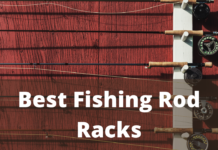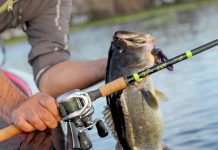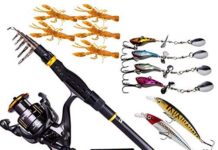Cane pole fishing might seem primitive compared to other types of rod fishing, but you’ll be pleasantly surprised by how fun and exciting it is, even if it is reel-free. But how do you get started on this fishing method that dates back generations?
We’ll walk you through everything you need to know about cane pole fishing, including how to make one!
What Is a Cane Pole?
Before buying your supplies for a DIY cane pole for fishing, you need to know what a cane pole is. Don’t worry, though. It is not as complex as you think it is.
A cane pole is a long stick that usually has a 1″-1-1/2″ butt diameter and is between 8-foot-20-foot in length. Some are made from bamboo, while others are graphite or fiberglass. Unlike modern fishing rods, a cane pole doesn’t have a reel, drag system, and line guide.
As a matter of fact, you will be using a line as long as the pole itself, if not a tad longer. The hook is at the end of the line, wherein you can use live or artificial baits.
What Are the Different Types of Cane Poles?
Bamboo fishing rods and poles are the most popular. However, there are other types of cane poles that you can use.
Telescopic Cane Poles

Telescopic poles are made from graphite or fiberglass instead of treated bamboo. This choice of material makes them more lightweight. Since they are collapsible, often shrinking half of their length, they are more compact for camping trips and air travel.
For convenience, many fiberglass telescopic poles also have add-ons like a metal eye tip and line keeper. Length can also vary too, ranging from 8-foot to 20-foot.
Calcutta Poles
Calcutta cane poles are made from solid bamboo, specifically the Calcutta Bamboo (Dendrocalamus Strictus) species. They are highly prized in the fishing community because of their strength and flexibility, which many argue is 100% better than fiberglass. A high-quality Calcutta Bamboo pole is also resistant to rot from saltwater.
These poles are available in various lengths, although most are between four and twenty-five feet long.
Pro Tip: The longevity of bamboo poles is determined by how well they are cared for.
Jigger Poles
Jigger poles are typically 15 to 20 feet long and can also be telescopic. They’re adaptable and great for fishing in places where traditional casting is tricky. Jigger poles can be bamboo, fiberglass, or graphite, among other materials. They’re strung with a short leader attached to the pole’s end and a plastic or wooden plug at the other end.
How to Rig a Cane Pole?
Rigging a cane pole is easier because there is no reel to deal with. However, it’s best first to secure your line lower down the pole’s body. This way, if the tip breaks under pressure, you won’t lose your line or fish.
Rigging a Bamboo Cane Pole
- Tie a piece of dacron or monofilament to the center of your pole, just below a notch.
- Twist the line to the tip of your bamboo pole by rotating the pole.
- Do a half hitch and secure the line in the slit you made in the tip when you get to the top.
- Make sure you have enough monofilament to reach the pole’s handle.
- At the end of the line, add a swivel or a hook. If you want to adjust the depth of the hook, add a bobber and any split shot you want.
- You can now put your bait to the test.
Rigging a Telescopic Cane Pole
Rigging a telescopic pole is as easy as stringing a bamboo rod. As a matter of fact, the procedure is nearly identical, except that there is a decreased danger of the tip breaking under stress.
How to Fish With a Cane Pole
Cane pole fishing is pretty simple, but since it doesn’t have any reel and your line is limited, it can be challenging at first. Here’s how you can master cane pole fishing.
- Lower your line into the water by gradually dipping the rod below and slowly raising it.
- Avoid moving it around too quickly or forcefully.
- Once you’ve hooked a fish, raise the pole above your head. This will bring the fish closer to the banks or boak.
- Then grab the fish, either by hand or net and remove the hook.
Cane Pole Fishing Techniques and Tips
You can use cane fishing poles to catch small to medium-sized fish, including bluegills, crappies, and catfish. If you target a larger fish like a Northern Pike, we suggest using a conventional fishing rod.
- Bass: If you want to catch bass, make sure you use a bait that can function in cover. The bait should also look as natural as possible to the bass.
- Trout: Use a tiny fly as bait and travel upstream to the stream’s or pool’s mouth. This approach entails carefully dangling the fly 2 or 3 inches over the water’s surface and occasionally touching it, just like a natural fly would.
- Bluegill & Crappie: While crappie and bluegill are generally easy to catch, a cane fishing pole allows you to get your bait into hard-to-reach areas near dense cover.
- Catfish: Use a slightly heavier line and anchor your line closer to the base of the pole because the weight of this fish can put a strain on your pole and potentially cause it to crack.
How to Make a Cane Fishing Pole?
You don’t need a sophisticated rod to catch fish at your nearby lake. The following is a step-by-step guide to making your cane fishing pole:
- Find a 10-foot to 20-foot long piece of bamboo. Choose one that is straight as much as possible.
- Cut the bamboo stalk below the knuckle closest to the ground, near the root.
- Remove any attached leaves, but be careful not to cut into the stalk itself.
- Cut the tip of the stalk just above the last knuckle.
- Allow the stalk to cure for a few weeks by hanging it in a dry location until it turns a solid tan hue. This ensures that the bamboo has dried thoroughly and will endure as long as feasible.
- Sand the base and the rest of the pole.
- Apply a coat or two of wood lacquer.
- Set up your fishing cane and get started.
Cane Pole Fishing FAQ
What Are the Best Baits for Cane Poles?
When using a cane rod or pole to catch fish, the most common species are bluegill and tiny catfish. When going after catfish, you’ll use a variety of baits, including earthworms, crickets, mealworms, and a minnow-shaped plug that floats.
How Long Should a Cane Pole Line Be
The rope’s length should be enough to extend from the pole’s tip to the bottom. This ensures that even if the pole’s very thin tip broke, you could still land a bigger fish.
How to Cure a Cane Pole for Fishing?
You can cure a cane pole for fishing by laying the bamboo on a flat surface. It can take several weeks to months before it completely cures. You will know that the pole is cured if its color changes from green to brown. Never put bamboo poles under direct sunlight because they will crack.
Back to Basics
Cane pole fishing offers you the opportunity to go back to the basics of fishing! It may seem primitive and outdated, but the joy of catching a fish without using any modern fishing gear is exhilarating! Plus, it is a terrific method to learn to fish without spending a lot of money.
Table of Contents



